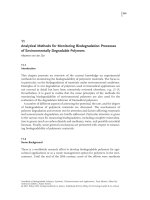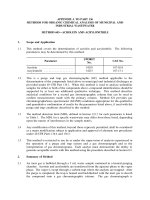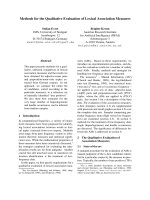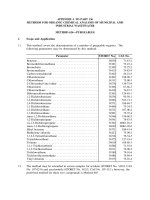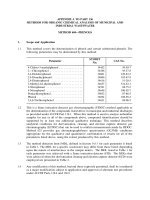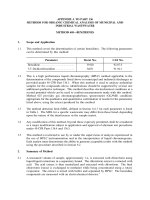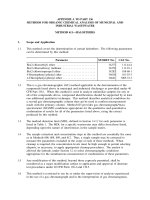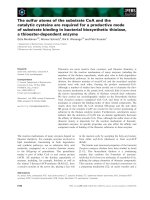Scientific report: "Adaptation methods for detecting microbial residues of antibacterial substances in shrimp in Vietnam" potx
Bạn đang xem bản rút gọn của tài liệu. Xem và tải ngay bản đầy đủ của tài liệu tại đây (335.01 KB, 11 trang )
J. Sci. Dev. 2009, 7 (Eng.Iss.1): 36 - 46 HA NOI UNIVERSITY OF AGRICULTURE
36
0Adaptation of a microbiological method to detect
antimicrobial residues in shrimp tissue from Vietnam
Thích ứng phương pháp vi sinh vật để phát hiện
tồn dư các chất có tính kháng khuẩn trong tôm ở Việt Nam
Pham Kim Dang
1
, Guy Degand
2
, Guy Maghuin-Rogister
2
and Marie-Louise SCIPPO
2
1
Department of Animal Biochemistry and Physiology, Faculty of Animal Science & Aquaculture,
Hanoi University of Agriculture, Vietnam
2
Laboratory of Foodstuff Analysis (LADA), Department of Food Sciences, Faculty of Veterinary
Medicine, University of Liege, Belgium
TÓM TẮT
Phương pháp vi sinh vật phát hiện các hợp chất có tính kháng khuẩn trong tôm đã được thích ứng
và chuẩn hoá dựa trên cơ sở nguyên lý "Test Thận" của Bỉ. Mục đích của nghiên cứu này là thích ứng
phương pháp "Test Thận" của Bỉ để phát hiện ba nhóm quinolone, sulfamid và tetracycline trong tôm ở
Việt Nam. Bacillus subtilis là chủng vi khuẩn đã được sử dụng trong phương pháp này. Độ nhạy của
phương pháp đã được xác định thông qua việc phân tích thử 13 dung dịch các chất chuẩn và mẫu trắng
được củng cố các chất có tính chất kháng khuẩn ở các nồng độ khác nhau. Kết quả phân tích các mẫu
tôm củng cố cho thấy phương pháp có phổ phát hiện rộng tại nồng độ thấp hơn hoặc bằng gia trị tồn
dư tối đa theo luật định. Hầu hết các chất thuộc nhóm Quinolone và nhóm Tetracycline được phát hiện
ở nồng độ thấp hơn giá trị tồn dư tối đa (Difloxacine tại 0,25 x MRL, Enrofloxacine và Flumequin tại 0,5 x
MRL, Tetracycline, Chlortetracycline, Danofloxacine và Ciprofloxacine tại 0,75 x MRL) ngoại trừ hai chất
(Oxytetracycline và axít oxolinic) và các sulfonamid được phát hiện ở nồng độ bằng giá trị giới hạn tồn
dư tối đa. Riêng Norfloxacine là chất không qui định giới hạn tồn dư tối đa được phát hiện ở nồng độ
100 ppb. Kết quả này là cơ sở ban đầu cho các nghiên cứu tiếp theo. Các thí nghiệm gây nhiễm thực
nghiệm sẽ được bố trí để tối ưu và chuẩn hoá bằng các mẫu nhiễm thực trước khi đưa vào phân tích tại
các phòng thí nghiệm kiểm soát tồn dư ở Việt Nam.
Từ khoá: Phát hiện kháng sinh, phương pháp vi sinh vật, tồn dư, tôm.
SUMMARY
The basic principle of the Belgian “Kidney Test” has been adapted and validated to detect
antimicrobial residues in shrimps. The aim of the present study was to adapt the “Kidney Test” to
detect three groups of antimicrobial (quinolones, tetracyclines and sulfonamids) widely used in
shrimp production in Vietnam. The method is a microbiological assay based on the use of Bacillus
subtilis. The sensibility of this method was established by analysing 13 antimicrobial standard
solutions and blank shrimp samples spiked with antimicrobials at different concentrations.
The results obtained with shrimp spiked with antimicrobial indicate that the method can detect a
wide range of compounds at or below MRL (Maximum Residue Limit). Most of the quinolones and
tetracyclines are detected at lower concentrations than the MRL level (Difloxacine at 0.25 x MRL,
enrofloxacine and flumequin at 0.5 x MRL, tetracycline, chlortetracycline, danofloxacine and
ciprofloxacine at 0.75 x MRL) with the exception of two antimicrobials (oxytetracycline and oxolinic
acid) and sulfonamids, which were detected at MRL. The norfloxacine (with no fixed MRL by EU) is
detected at 100ng/g. These preliminary results are promising and will be the basis for future research.
Shrimp contamination experiments will be realized to optimize, evaluated and standardised the
method with incurred samples before the routine use of these methods, in the quality control
laboratories in Vietnam.
Key words: Antibiotic detection, microbiological inhibition test, residue, shrimp.
Adaptation of a microbiological method to detect antimicrobial residues
37
1. INTRODUCTION
In Vietnam, fisheries and aquaculture, two
important sectors of food production, is rapidly
increasing and play an importance role in the
economic growth, which is of 7-8% per year. Most
of the production in this country is exported,
generating large amounts of foreign exchange. The
fisheries and aquaculture export values in 2007
were USD 3.7 billions in total, which corresponds
to an increase of 9 % over 2006, with more than 40
% coming from shrimp product (FICEN, 2007).
The total fisheries and aquaculture export value of
period from 2001 to 2007 is more than USD 16
billions, with an average growth rate of more than
10% per year. However, Vietnam faces difficulties
such as trade competition, anti-dumping regulations
and high food safety requirements of importers and
local consumers. Therefore, this problem has been
discussed many at times in recent regular meetings
of the Vietnam National Assembly.
The recent decades have seen significant
progress in the development of quantitative
confirmatory methods for the detection of
antimicrobial residues. But due to complicated and
cost-intensive methods used for analysis, the results
received still limit. Therefore, microbiological
methods retain a vital role in antimicrobial residue
analysis because of their broad-spectrum
characteristics, which make them the most suitable
(and so far, the only feasible) option for screening.
Furthermore, they are simple and inexpensive to
perform.
Microbiological inhibition screening tests are
widely used and play an important role in the
detection of antimicrobial residues in many
countries of the World (Ferrini et al. 1997;
Myllyniemi et al. 2000; Popelka et al. 2005). Many
microbiological tests are investigated, developed
and adapted for the detection of antimicrobial
residues in the different animal food products
(Cooper et al. 1998) such as Four Plate Test (FPT)
(Bogaerts & Wolf 1980), Belgian Kidney Test
(BKT) or One Plate Test (Koenen-Dierick et al.
1995), Three Plate (Okerman et al. 2001) and New
Dutch Kidney Test (NDKT) (Nouws et al. 1988).
Presently, the Belgian Kidney Test is used to
determine the presence of residual antibacterial
substances in the residue official control
programme of Belgium. This “pre-screening”
microbiological test is applied on kidneys of
slaughtered animals (Anonymous, 1995).
Advantages of this method are that the test is
simple, easy-to-use, and inexpensive and allows a
broad-spectrum antimicrobial screening. In
practice, many microbiological methods are
developed, validated and adopted to detect
antimicrobial residues in different matrices of
different animal products, but there are very few
available for the aquaculture products in general,
and for shrimp in particular.
The aim of the present study was to adopt the
“Kidney Test” to detect three groups of
antimicrobials (quinolones, tetracyclines and
sulfamides) widely used in shrimp production in
Vietnam, and to validate this test according to
criteria of European Commission.
2. MATERIALS AND METHODS
All of antimicrobial standards used in this
study were provided by Sigma-Aldrich (St Louis,
MO, USA), except danofloxacin which was from
Pfizer (Groton, CT, USA).
Stock solutions (1mg/ml) were prepared in
methanol, except for three sulfonamides
(sulfamethoxazole, sulfadiazin, sulfadimethoxin)
and 7 (fluoro) quinolones (oxolinic acid,
danofloxacin, enrofloxacin, difloxacin, flumequin,
ciprofloxacin, norfloxacin), which were dissolved
in a small volume of HCl 2N for sulfonamides and
in NH
4
OH 2M for quinolones before methanol
addition.
Standard working solutions: Standard
working solutions were prepared by diluting stock
solutions in purified sterile water.
Culture media: Culture media used were
Standard II Nutrient Agar for microbiology
(Merck 1.07883, Darmstadt, Germany). Media
were prepared as recommended by the Ministry of
public health and environment of Belgium
(Anonymous, 1995) with two modifications (0.6%
dextrose and 0.4 g TMP/ml culture).
Bacterial strain: Bacillus subtilis strain BGA
spore suspension was commercially available in
standardized concentration of 10
7
spores/ml
(Merck 1.10649, Darmstadt, Germany).
"Blank" samples were shrimp samples
confirmed to not contain antimicrobial by
LC/MSMS method and were provided by CART
(Centre d’Analyse des Résidus en Traces) of the
University of Liége, Belgium.
PABA (para-aminobenzoïc acid) and
trimethoprime (TMP) were provided by Sigma-
Aldrich (Steinheim, Germany).
Pham Kim Dang, Guy Degand, Guy Maghuin-Rogister and Marie-Louise SCIPPO
38
Sample extraction: the extraction method was
adopted from the Premi - Test as described for
other matrices (Stead et al. 2004). Three grams of
shrimp homogenate was extracted in
Acetonitrile/Acetone (70/30 v/v) under rotative
shaking during 10 minutes. The mixture was then
centrifuged at 3000 rpm for 10 minutes at 15°C.
The supernatant was transferred into a clean conical
tube and evaporated to dryness under N
2
at 40°C.
The dry residue was dissolved in 200 l methanol.
Microbiological test: The extract was
centrifuged again and the 50 l of the supernatant
was applied on paper disc on the seeded agar plates
with Bacillus subtilis. Plates were then incubated for
24 h at 30°C, before to measure inhibitions zones.
Result interpretation: According to other
microbiological tests (FPT, NDKT), we considered
a result as positive or suspect if the diameter of the
inhibition zone (including the paper disc) was equal
or higher than 16 mm, or if the size of the inhibition
zone around the paper disc was equal or higher than
2 mm.
Method optimization: Standard quality
control was performed with 50 l of each of the
13 standard solutions at a concentration of 20
g/ml (=1 g of antimicrobial per disc).
Then MIQ (Minimum Inhibitory Quantity) is
the minimum quantity of antimicrobial capable to
produce an inhibition zone which is equal or bigger
than 2 mm. The MIQ was determined by using 13
standard solutions in the range of concentration
from 625 to 3500 ng/ml. On the basis of the MIQ
and the MRL (maximum residue limit) of each
antimicrobial, the minimal shrimp quantity (MSQ)
to be used for the analysis was determined using
the following formula:
MSQ (g) = MIQ (ng) * MRL
-1
(g/ng)
Then LODs (Limit of detection) for each
antimicrobial was determined by analysing 20
spiked samples.
The method was validated following the
“Guide for analytical validation of screening
methods” written by the CRL (Community
Reference Laboratory), AFSSA, Fougères, France.
The accuracy, sensitivity and selectivity were
determined by analysing 20 “blank” samples and
20 spiked samples.
Identification of the family of antimicrobials:
the sulfonamide group was identified by adding,
together with the sample extract, 10 l of PABA
solution (100 g/ml) on the paper disc.
3. RESULTS AND DISCUSSION
3.1. Standard Quality Controls
To evaluate the plate quality and the
sensitivity of B. subtilis to tested antimicrobials,
50 l of each of the 13 standard solutions at the
concentration of 20 g/ml were analyzed on 12
mm diameter paper discs.
Each antimicrobial was tested with 12
repetitions (3 repetitions in 4 independent series of
disk preparation) on 4 different days (4
independent preparations of medium).
All the 13 antimicrobials of the 3 tested
groups were able to induce an inhibition zone. The
mean diameters of inhibition zones of the majority
of tested antimicrobials were 28 mm with
coefficient of variation (CV) of 3 - 6% (Table 1).
The mean of the inhibition zones induced by
sulfonamides was lower than 26 mm (Sulfadiazine:
23
1mm, CV = 5%; Sulfadimethoxine: 24
1mm, CV = 5%; Sulfamethoxazole: 25
1 mm,
CV = 4 %).
The means of inhibition zones obtained for
quinolones were higher than 32 mm, except for
norfloxacine (28
1 mm and CV = 5 %). Among
them, enrofloxacine induced the est inhibition zone
(36
1 mm) with a CV = 3%. For danofloxacine,
difloxacine, ciprofloxacine, oxolinic acid and
flumequine, the diameters of the inhibition zones
were respectively of 35
2 mm, 34
1 mm ;
33
2 mm; 33
2 mm and 32
2 mm.
The means of inhibition zones generated by
Tetracycline was 29
1 mm, by oxytetracycline
was 28
1 mm and by chlotetracycline was 32
2 mm, with CV of 5 and 6% respectively.
The results in Table 1 also showed that the
means of inhibition zones for the 3 tested
antimicrobial groups were statistically different
with p <0.05 (24 ± 1 mm for sulfonamide, 30 ± 2
mm for tetracyclines and 33 ± 3 mm for
quinolones).
These results showed that the Bacillus subtilis
strain chosen and the gelose composition were fully
adapted for the detection of the 3 antimicrobial
groups of interest.
In the aim to improve the sensitivity of the test
for tetracycline and sulfonamide, we increased the
dextrose and TMP concentrations respectively from
0.4 to 0.6 % and from 0.2 to 0.4 %. The diameters of
the inhibition zones of all the tested antimicrobials
in control tests (1 µg /disk) were equal or higher
Adaptation of a microbiological method to detect antimicrobial residues
39
Table 1. Diameters of inhibition zones generated by antimicrobial standards
(1 g of standard/disc)
Diameters of inhibition zones (n = 12)
(mm)
Groups Antimicrobials
a
X
s
a
Max Min CV (%)
g
X
s
g
Tetracycline
29
1
30 26 5
Oxytetracycline
28
1
31 26 5
Tetracyclins
Chlortetracycline
32
2
35 27 6
30 ± 2
Sulfadiazine
23
1
25 22 5
Sulfadimethoxine
24
1
26 22 5
Sulfonamids
Sulfamethoxazole
25
1
27 23 4
24 ± 1
Oxolinic Acid
33
2
36 31 5
Danofloxacine
35
2
38 33 4
Difloxacine
34
1
37 32 4
Ciprofloxacine
33
2
36 30 5
Norfloxacine
28
1
30 26 5
Flumequine
32
2
35 29 5
Quinolones
Enrofloxacine
36
1
38 34 3
33 ± 3
a
X
, s
a
= mean diameter of inhibition zone and standard deviation for each antimicrobial
g
X
, s
g
= mean diameter of inhibition zone and standard deviation for each antimicrobial group
than 23 mm, the lower sensitivity was for
sulfadiazine (diameter mean of inhibition zones
was 23 mm, varying between 22 and 25 mm).
These results are accepted for the Four-Plate Test
(Bogaerts & Wolf 1980).
According to the recommendations for BKT,
the diameters of inhibition zones in control tests (1
g /disk) have to be at least 17 mm for sulfamide
and 18 mm for oxytetracycline (Anonymous,
1995). So, we can consider that the sensitivity of
our method is suitable to detect the 3 antimicrobial
groups tested.
3.2. Test evaluation with standard
antimicrobial solutions
3.2.1. Determination of the minimal
inhibitory quantity (MIQ)
The MIQ is very necessary for establishing
and adjusting the sample extraction procedure.
Based on measured MIQ and on MRL of each
antimicrobial (fixed by regulation 2377/90/CEE), it
is possible to determine the minimal shrimp
quantity to be used for the analysis.
Thirteen standard solutions, of concentrations
varying from 625 to 3.500 ng/ml, were used for the
evaluation of the MIQ. Fifty l of standard solution
was dripped on the paper disks laid on the Petri
plate. Each standard solution at each concentration
was tested in 8 repetitions with 4 series of Petri
plate, on 4 different days.
Pham Kim Dang, Guy Degand, Guy Maghuin-Rogister and Marie-Louise SCIPPO
40
0,0
1,0
2,0
3,0
4,0
5,0
6,0
25,00 37,50 50,00 62,50 75,00 87,50 100,00 112,50 125,00 137,50 150,00 162,50 175,00
Quantity of standard/disk (ng)
Width of inhibition zone around the disk (mm)
Danofloxacine Oxolinic acid Difloxacine
Ciprofloxacine Norfloxacine Enrofloxacine
Flumequine Sulfadiazine Sulfadimethoxine
Sulfamethoxazole Chlortetracycline Oxytetracycline
Tetracycline
Fig. 1. Width of inhibition zones around the disk depending on quinolone, sulfonamide
and tetracycline quantity in 50 l of standard solution (or per disc)
Table 2. Determining minimal shrimp quantity to be sampled for an extraction
Antimicrobials
MRLs
(*)
(ng/g)
MIQ
(ng/disk)
Minimal shrimp quantity to be sampled
for extraction (in 50µl of the final
extraction solution) (g)
Minimal shrimp quantity
to be sampled for an
extraction
(***)
(g)
Tetracycline 100 50 - 62.5 0.6250 2.0 - 2.5
Oxytetracycline 100 62.5 0.6250 2.5
Chlortetracycline 100 50 - 62.5 0.6250 2.0 - 2.5
Sulfadiazine 100 75.0 0.7500 3.0
Sulfadimethoxine 100 62.5 - 75.0 0.7500 2.5 - 3.0
Sulfamethoxazole 100 62.5 - 75.0 0.7500 2.5 - 3.0
Oxolinic acid 100 62.5 0.6250 2.5
Danofloxacine 100 37.5 - 50.0 0.5000 1.5 - 2.0
Difloxacine 300 50 - 62.5 0.6250 2.0 - 2.5
Ciprofloxacine 100 50 - 62.5 0.6250 2.0 - 2.5
Norfloxacine ** 62.5 0.6250 2.5
Flumequine 200 62.5 0.3125 1.25
Enrofloxacine 100 37.5 - 50.0 0.5000 1.5 - 2.0
(*)
: MRLs fixed by regulation 2377/90/CEE (CE, 1990) **: without fixed MRL
(***): if dry residue after the last evaporation step is dissolved in 200 µl of methanol
Adaptation of a microbiological method to detect antimicrobial residues
41
As expected, the width of the inhibition zones
around the disks loaded with 50 µl of standard
solution varied with the function of concentrations.
The dose-response curves of the 3 tested
antimicrobial groups were different. At the same
concentration, quinolones could create the larger
inhibition zone, followed by tetracycline, and then,
sulfonamide (Fig.1). Concretely, danofloxacine and
enrofloxacine produced an inhibition zone higher
than 2 mm at concentrations between 37.50 and 50
ng/disk, while the other 5 quinolones as well as the
3 tetracyclines produced the same inhibition zones
at 50 - 62.5 ng/disk. Meanwhile, sulfonamide
induced inhibition zones 2 mm on the disk only
with the minimal concentration of 75ng of
antimicrobial per disc.
Thus, the B. subtilis strain in the above-
mentioned adjusted medium was the most sensitive
to danofloxacine and enrofloxacine (MIQ varied
from 37.5 to 50 ng/disk), followed by the other
quinolones and the 3 tetracyclines (MIQ varied
from 50 to 62.5 ng/disk). The lower sensitivity was
for tested sulfonamide with MIQ varying from 62.5
to 75 ng/disk (Figure 1).
These results were in full concordance with
those obtained by Currie and co-workers (Currie et
al, 1998) in their study on the evaluation of the FPT
method.
3.2.2. Determination of the minimal
quantity of shrimps to be sampled
for an extraction
In order to detect antimicrobials in samples, an
extraction procedure is applied. Based on the
extraction procedure, the maximum residue limit
(MRL) fixed by EU and the MIQ (ng in 50 l/disk),
we calculated the minimal shrimp quantity (MSQ)
to be taken for an extraction using the formula
mentioned in the material and methods section.
If the dry residue after the evaporation step
following the extraction is recovered in 200 l of
methanol, and if 50 µl are applied on a disk, the
minimal shrimp quantity for an extraction will be 4
times the MSQ.
The results in Table 2 show that it is necessary
to sample at least 3 grams of shrimp tissue for an
extraction to detect all antimicrobial groups tested
at a concentration equal or lower MRL.
3.3. Validation
3.3.1. Detection threshold
Validation of residue screening methods is
most often done using samples spiked with the
analyses at the required concentration, because it is
impossible to produce incurred samples from
different animal species with a specified
concentration of residue. Nevertheless, this poses a
problem when intact meat has to be analysed, as it
is prescribed for the FPT (Heitzman 1994). To
avoid the difficulty of producing spiked undiluted
samples, the meat fluid spiked was used in some
investigations. For practical reasons, it was
supposed that the antibacterial substance
concentration in the fluid was approximately equal
to the antibacterial substance in the whole tissue
(Okerman et al. 2004).
According to the decision of the European
Commission 2002/657/CE, the detection capability
can be investigated with fortified blank material at
the decision limit (MRL). The aim is to find the
concentration level where false compliant results
are less than 5% (maximum 1 false compliant out
of 20 fortified samples). Therefore, at least 20
investigations for at least one concentration level
have to be carried out in order to ensure a reliable
basis for this determination.
This method was validated by using ground
and fortified blank samples with standard
antimicrobials of the 3 tested groups. After
fortification, the samples were kept for one night at
4
0
C before extraction.
The LOD of the method for each antimicrobial
was identified by analyzing 20 fortified samples at
interesting concentrations. The results showed that
the method is capable of detecting antimicrobials
tested at concentrations very close to MRLs. All the
tested antimicrobials were detected at
concentrations MRL, except for sulfonamide,
which were detected at levels equal to 1.25 x MRL.
Two antimicrobials were detected at 0.75 x MRL:
Enrofloxacine and flumequine. Oxytetracycline and
oxolinic acid were detected at levels just equal to
MRL and difloxacine at 0.25 MRL. Norfloxacine
which had no MRL established was detected at 100
g/kg.
The detection threshold is the fortified
concentration, at which 5% or less of the samples
are not detected. In this study, among 20 samples
analyzed at a fortified concentration, a unique
sample had negative results. The percentage of 5%
was chosen from critical concentration beta (CC
or
Detection capability) described in the Decision of
the European Commission N°2002/657/EC
Pham Kim Dang, Guy Degand, Guy Maghuin-Rogister and Marie-Louise SCIPPO
42
(European Commission, 2002). The beta error (rate
of "false positive") has to be 5% or less for those
compounds having a MRL, and 1% or less for those
compounds fully prohibited. Based on MIQ of each
antimicrobial and its MRL, we have fortified the
blank samples at concentrations calculated to take
into account loss of analyses during the extraction.
For each antimicrobial, we analyzed 20
fortified samples at different concentrations. For
quinolones and tetracyclines, blank samples
fortified at 2 different concentrations were analyzed
(MRL and 0.75 x MRL, for norfloxacine which
haven’t got MRL, at 75 and 100 ng/g).
Chlotetracycline, enrofloxacine and danofloxacine
were tested at 0.5 x MRL and 0.75 x MRL, for
difloxacine at 0.25 x MRL and 0.5 x MRL. For
sulfonamide, the samples were fortified at higher
concentrations (MRL and 1.25 x MRL).
The results indicated in Table 3 reveal that
among the 13 antimicrobials of the 3 tested groups,
7 antimicrobials were detected at the concentrations
lower than MRL, concretely:
Difloxacine at 0.25 x MRL
Enrofloxacine and Flumequine at 0.5 x MRL
Tetracycline, Chlotetracycline, Danofloxacine,
and Ciprofloxacine at 0.75 x MRL.
Two antimicrobials were detected at their
MRLs: Oxytetracycline and oxolinic acid
(Norfloxacine was detected at 100 ng/g).
At last, 3 antimicrobials of the sulfonamide
group were detected at a threshold slightly higher
than MRL (125 ng/g or 1.25 x MRL).
3.3.2. Sensitivity, Specificity and Accuracy
According to the recommendations of CRL, in
order to reduce cost and labour of the evaluation of
parameters related to the method performance, it is
possible to choose some representative
antimicrobials of the groups (Gaudin & Sanders
2005). The chosen representative antimicrobials are
those which have similar antibacterial activities and
are the most frequently used in the shrimp
production.
For each group, 2 representative standard
antimicrobials were chosen. For each representative
antimicrobial, we analyzed 20 “Blank” samples
(considered as "True Negatives") and 20 fortified
“bank” samples at the concentration at the detection
threshold ("True Positives"). Obtained data are
calculated and presented in Table 4.
Table 3. Detection threshold of the method
First Assay Second Assay
Groups Standards
MRLs
(*)
(ng/g)
Tested
concentration
(ng/g)
Number of
positive samples
(inhibition zone
≥ 2 mm)
Tested
concentration
(ng/g)
Number of
positive
samples
(inhibition
zone ≥ 2 mm)
LOD
(ng/g)
Tetracycline 100 75 19/20 100 20/20 75
Oxytetracycline 100 75 1/20 100 19/20 100
Tetracyclin
Chlortetracycline 100 75 20/20 100 20/20 75
Sulfadiazine 100 100 1/20 125 19/20 125
Sulfadimethoxine 100 100 2/20 125 19/20 125
Sulfonamid
Sulfamethoxazole 100 100 0/20 125 19/20 125
Oxolinic acid 100 75 0/20 100 19/20 100
Danofloxacine 100 50 0/20 75 20/20 75
Difloxacine 300 75 20/20 150 20/20 75
Ciprofloxacine 100 75 20/20 100 20/20 75
Norfloxacine (**)
75 0/20 100 19/20 100
Flumequine 200 100 19/20 150 20/20 100
Quinolone
Enrofloxacine 100 50 20/20 75 20/20 50
(*)
: MRLs fixed by regulation 2377/90/EC ** : without fixed MRL
Adaptation of a microbiological method to detect antimicrobial residues
43
Table 4. Performance parameters of the method for the 3 tested antimicrobial groups
Test concentration Performance characteristics
Groups
Representative
antimicrobials
MRLs
(*)
(ng/g)
(ng/g) (MRL)
Accuracy
(%)
Sensitivity
(%)
Tetracycline 100 75 0.75 97.5 95
Tetracyclin
Chlotetracycline 100 75 0.75 100 100
Sulfadiazine 100 125 1.25 97.5 95
Sulfadimethoxine 100 125 1.25 97.5 95
Sulfadiazine** 100 100 1.00 97.5 95
Sulfamid
Sulfadimethoxine** 100 100 1.00 97.5 95
Enrofloxacin 100 50 0.5 100 100
Quinolone
Flumequin 200 100 0.5 97.5 95
(*)
: MRLs fixed by regulation 2377/90/EC ** : loading of 63 µl of extraction solution/disk
The results in Table 4 show that this method
was able to detect the 3 antimicrobial groups tested
at a concentration very close to their MRL with
acceptable accuracy and sensitivity. The accuracy
and sensitivity of the method were 100% for
chlotetracycline at 0.75 x MRL and for
enrofloxacine at 0.5 x MRL. As for other
antimicrobials, the method can detect
antimicrobials at 0.75 x MRL (for tetracycline), at
0.5 x MRL (for flumequine) and at 1.25 x MRL
(for 2 sulfonamids) with an accuracy and a
sensitivity of 97.5% and 95% respectively. The
specificity of the method (assessed by the
percentage of really negative samples after the
screening) is 100%.
The accuracy and the sensitivity of the method
for the 2 sulfonamides fortified at MRL when
loading 63 l of sample extract on a disk, was the
same at the fortified concentration of 1.25 x MRL
than when loading 50 l/disk.
For tetracyclines and quinolones, the accuracy
and the sensitivity of the method are 100% when
analyzing fortified samples at MRL.
According to European Commission
2002/657/EC, reports of residue tests should not
mention positive and negative results, but the
terms "non-compliant" and "compliant" should be
used. A screening test result can be either
compliant or suspect. However, the result can only
be considered as compliant when the detection
capability of the screening test is below the MRL
for a given analyse. The actual multiresidue test
relying on inhibiting characteristics of
antimicrobials do not detect all antimicrobials at
MRL levels, and as long as the test is not
validated for a given antimicrobial or group of
antimicrobials, it is not known if the result is
compliant or not. For example, a negative Premi
Test result does not allow deciding that the sample
is compliant for tetracyclines, and a negative FPT
result does not mean that the sample is compliant
for sulfonamide (Korsrud et al., 1998), although
both tests are intended as general screening tests
for antibiotics. Indeed, they do not detect samples
contaminated with the respective analytes at MRL
levels. Therefore, as the terms “suspect”,
“compliant” and “not compliant” are to be
considered as juridical rather than scientific.
Therefore, through the analyses of “blank”
samples and fortified samples with 6 representative
antimicrobials of the 3 groups, the accuracy and the
sensitivity of the method are established. The
method ensures the detection capability of these 3
groups with acceptable accuracy and sensitivity.
The accuracy of the method is higher or equal to
95% for all the 6 representative antimicrobials at
concentrations equal to LOD. These results are
satisfying and meet minimal demands of Decision
N
0
2002/657/EC.
3.4. Results of identification tests of
antimicrobials
An ideal antimicrobial multiresidue method
would detect and identify all licensed
antimicrobials at or below their MRLs
Pham Kim Dang, Guy Degand, Guy Maghuin-Rogister and Marie-Louise SCIPPO
44
Table 5. Results of antimicrobial group identification
Number of positive samples
(Width of inhibition zone >= 2 mm)
Samples
Disc N°1 (50 µl of
solution after
extraction)
Disc N°2 (63 µl of
solution after
extraction)
Disc N°3 (63 µl of solution
after extraction + 10 µl of
PABA)
"Blank sample"
(n = 5)
0/5 0/5 0/5
Spiked samples with Sulfadiazine
(125 ppb) (n = 5)
5/5 5/5 0/5
Spiked samples with Sulfadiazine
(100 ppb) (n = 5)
0/5 5/5 0/5
Spiked samples with Sulfadiazine
(50 ppb) (n = 5)
0/5 0/5 0/5
Spiked samples with Enrofloxacine
(50 ppb) (n = 5)
5/5 5/5 5/5
Spiked samples with Enrofloxacine
(25 ppb) (n = 5)
0/5 2/5 2/5
Spiked samples with Tetracycline
(100 ppb) (n = 5)
5/5 5/5 5/5
Spiked samples with Tetracycline
(50 ppb) (n = 5)
0/5 0/5 0/5
Table 6. Interpretation of results and identification of sulfonamids
Disc N°1
(50 µl of
solution
after
extraction)
Disc N°2
(63 µl of
solution
after
extraction)
Disc N°3
(63 µl of solution
after extraction +
10 µl PABA)
Identification
- - - Negative
- + - Sulfonamide (100 to 125 ppb)
+ + - Sulfamide (>= 125 ppb)
+ + + Quinolone or tetracycline or antimicrobial of other groups (> = LOD)
- + + Quinolone or tetracycline or antimicrobial of other groups (< LOD)
A multi - residue analysis method will be ideal
if it is able to detect and identify all chemicals at or
below their MRLs. These methods have been
developed and adapted in order to detect residues
of several antibiotic groups in different matrices.
Typically, the FPT method, the Premi
Test and
other microorganism tests were developed, based on
combining many plates, many pH levels, different
media and strain of microorganisms sensitive to
different antibiotic groups (Calderon et al. 1996).
Adaptation of a microbiological method to detect antimicrobial residues
45
These methods were used to screen positive
samples before formatting and confirmatory analyses
by means of other accurate methods.
The mechanism of action of sulfonamides is
the inhibition of the synthesis of the dihydrofolic
acid in the biosynthesis of folic acid in prokaryote
cells (Rang & Dale 1994). During the synthesis of
folic acid, there is a competition between
sulfonamides and PABA. By adding an excess of
PABA, sufonamides can not compete any more,
and they lose their inhibitory properties. By using
this technique (addition of PABA), we have
successfully identified shrimp samples fortified
with sulfonamides. This technique was also
successfully applied in other tests such as Premi
Test (Stead et al. 2004), CPMA (Combined Plates
Microbial Assay) (Ferrini et al. 1997).
Based on obtained results, in order to detect
sulfonamides at their MRL, it is necessary to load
63 l of sample extract after extraction.
The strategy to detect the 3 antimicrobial
groups of interest at least their MRL is the
following: 3 paper disks numbered 1, 2 and 3, were
laid on each Petri box, we load 50 l of sample
extract on disk 1, sixty three l on disks 2 and 3.
The third disk is for the detection of sulfonamides
and is added with 10 l PABA (100 g/ml).
In order to confirm the inhibition capability of
PABA on sulfonamides, we used standard
antimicrobial solutions. We have loaded 50 l of the
standard solution at a concentration of 20 g/ml on
the disk (1 g/disk is equivalent to 13 times of
QMI) in presence or absence of 10 l of PABA
(100 g/ml). In case of absence of PABA, all tested
sulfonamides were able to produce inhibition
zones, on the contrary, in presence of PABA, no
inhibition zones appeared.
We carried out a test to confirm the ability to
identify the sulfonamide group by analyzing blank
and fortified samples with different standard
antimicrobials as described in Table 6. This table
indicates that the identification of sulfonamide
groups is completely done by this method.
Concretely, if the inhibition zone width of all
the 3 disks is 2 mm, it is possible to conclude that
these samples are not contaminated with
sulfonamides, (or they may be contaminated at
concentration smaller than MRL), but well with
antimicrobials from the other groups. In this case, it
is possible to use specific methods in order to
identify antimicrobial groups, for example, Tetra-
sensor for tetracycline and ELISA for quinolone
before reconfirmation by other accurate physico-
chemical methods.
For other cases, Table 6 (in which the sign
" + " corresponds to an inhibition zone 2 mm, and
the signs " - " is the contrary) indicates how to
interpret the results.
4. CONCLUSION
Owing to 2 modifications in medium
composition in comparison with the Belgian
Kidney Test (dextrose 6%, TMP 0.4%) and an
extraction procedure by the mixture of
acetonitrile/acetone (70 :30 v/v), we succeeded to
improve the sensitivity of the microbiological
method described here. The initial results of our
study showed that the method was able to detect the
3 antimicrobial groups at concentrations very close
to their MRL, with accuracy and a sensitivity which
are satisfying and meets demands of the Decision
of the European Commission N
0
2002/657/CE.
The identification of sulfonamides, in a post-
screening step, was also successfully tested.
These preliminary results are promising and
will be the basis for future research.
Standardization and optimization of detection
methods for the antimicrobial contamination in
shrimps need to be carried out to use it routinely in
quality control laboratories in Vietnam.
Acknowledgements
This study was co-financially supported by
BTC (Belgian Technical Cooperation) and was
realized in Laboratory of Food Analysis,
Department of Food Sciences, University of LiÌge -
Belgium.
REFERENCES
Bogaerts, R. & Wolf, F. (1980). A standardized
method for the detection of residues of
antibacterial substances in fresh meat. A report
of the working group of the Scientific
Veterinary Commission of the European
Communities concerning a proposal for a
common microbiological method, the so-called
EEC four-plate method. Fleischwirtschaft
60(4), 667-669.
Calderon, V. Gonzalez, J. Diez, P. & Berenguer, J.
A. (1996). Evaluation of a multiple bioassay
technique for determination of antibiotic
Pham Kim Dang, Guy Degand, Guy Maghuin-Rogister and Marie-Louise SCIPPO
46
residues in meat with standard solutions of
antimicrobials. Food Additives and
Contaminants 13(1), 13-19.
Communauti Europienne (CE) (1990). Réglement
(CEE ) n°2377/90 du Conseil du 26 juin 1990
Itablissant une procédure communautaire pour
la fixation des limites maximales de résidus de
médicaments vétérinaires dans les aliments
d’origine animale. J. Off. Comm. Eur. L 224, 1.
Communauté Européenne (CE) (2002). Décision
N° 2002/657/CE du 12 aout 2002 portant
modalités d'application de la directive
96/23/CE du Conseil en ce qui concerne les
performances des méthodes d'analyse et
l'interprétation des résultats (Texte présentant
de l'intérêt pour l'EEE) [notifiée sous le numéro
C(2002) 3044]. J. Off. Comm. Eur.L221, 8-36
Cooper, A. D. Tarbin, J. A. Farrington, W. H. H.
& Shearer, G. (1998). Effects of extraction and
spiking procedures on the determination of
incurred residues of oxytetracycline in cattle
kidney. Food Additives and Contaminants
15(6), 645-650.
Currie, D. Lynas, L. Kennedy, D. G. &
Mccaughey, W. J. (1998). Evaluation of a
modified EC four plate method to detect
antimicrobial drugs. Food Additives and
Contaminants 15(6), 651-660.
Ferrini, A. M. Mannoni, V. & Aureli, P. (1997).
The combined plates microbial assay (CPMA)
technique for the detection and presumptive
identification of beta -lactam, sulfonamide,
streptomycin and tetracycline residues in meat.
Archiv fur Lebensmittelhygiene 48(6), 133-135.
FIsheries Scientfic - Technological Economic
Information of Vietnam (FICEN) (2007).
Export statistics.
Gaudin, V. & Sanders, P. (2005). Guide for
analytical validation of screening methods.
Draft document, version 2, 19/10/2005. Internal
document of Laboratoire d’études et de
recherches sur les Médicaments Vétérinaires et
les Désinfectants - AFSSA Fougéres, France.
Heitzman, R. J. (Ed) (1994). Veterinary drug
residues. Residues in food producing animals
and their products: reference materials and
methods. Oxford, UK.: Blackwell Scientific
Publications.
Koenen-Dierick, K. Okerman, L. Zutter, L. D.
Degroodt, J. M. Hoof, J. V. & Srebrnik, S.
(1995). A one-plate microbiological screening
test for antibiotic residue testing in kidney
tissue and meat: an alternative to the EEC four-
plate method? Food Additives and
Contaminants 12(1), 77-82.
Anonymous (1995). Arrêté ministériel du 19 juin
1995 modifiant l’arrêté ministériel du 18
décembre 1973 déterminant les techniques de
laboratoire pour la recherche des résidus de
substance à effet bactériostatique. Monit. Belg.,
20368-20370.
Myllyniemi, A. L. Rannikko, R. Lindfors, E.
Niemi, A. & Backman, C. (2000).
Microbiological and chemical detection of
incurred penicillin G, oxytetracycline,
enrofloxacin and ciprofloxacin residues in
bovine and porcine tissues. Food Additives and
Contaminants 17(12), 991-1000.
Nouws, J. F. M. Broex, N. J. G. Hartog, J. M. P.
D. & Driessens, F. (1988). The new Dutch
kidney test. Archiv fur Lebensmittelhygiene
39(6), 135-138.
Okerman, L. Croubels, S. Cherlet, M. De Wasch,
K. De Backer, P. & Van Hoof, J. (2004).
Evaluation and establishing the performance of
different screening tests for tetracycline
residues in animal tissues. Food Additives and
Contaminants 21(2), 145-153.
Okerman, L. Croubels, S. De Baere, S. Van Hoof,
J. De Backer, P. & De Brabander, H. (2001).
Inhibition tests for detection and presumptive
identification of tetracyclines, beta-lactam
antibiotics and quinolones in poultry meat.
Food Additives and Contaminants 18(5), 385-
393.
Popelka, P. Nagy, J. Germuska, R. Marcincak, S.
Jevinova, P. & Rijk, A. D. (2005). Comparison
of various assays used for detection of beta-
lactam antibiotics in poultry meat. Food
Additives and Contaminants 22(6), 557-562.
Rang, H. P. & Dale, M. M. (1994).
Pharmacology. Churchill Livingstone:
Edinburgh.
Stead, S. Sharman, M. Tarbin, J. A. Gibson, E.
Richmond, S. Stark, J. & Geijp, E. (2004).
Meeting maximum residue limits: an improved
screening technique for the rapid detection of
antimicrobial residues in animal food products.
Food Additives and Contaminants 21(3), 216-
221.
